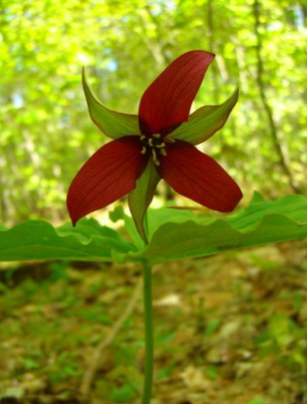
It’s a lovely time of year to get outside for a romp through a nearby forest. By braving the mud and puddles, you can often be rewarded by some solitude from the regular summer and fall crowds, and wildflowers in spring are quite a sight.
One of the best-known flowers of spring is the White Trillium (Trillium grandiflora), our provincial flower. In fact, if you encounter any Trillium in our watershed, it is likely to be this one. Its large petals give it an alternate name of Large-flowered Trillium. Its petals are the longest of the four trilliums in our watershed. Its petals are indeed white, but can take on a pinkish hue with age. It is found in rich deciduous woods and often grows so abundantly as to appear to carpet the forest floor.
In addition to White Trillium, three other species are found in our watershed: Red Trillium, Painted Trillium and Nodding Trillium. Red Trillium (Trillium erectum) is the second-most common Trillium species in our watershed. It has brilliant crimson petals and is a thrill to encounter. It is reported to have a bad odour, giving it the alternate name of Stinking Benjamin. It is found in moist woods.
Painted Trillium and Nodding Trillium are quite rare in our watershed. In fact, I’m aware of only one location for Nodding Trillium, which is on private land a few kilometres from Caledon Lake. Painted Trillium is also quite rare in our watershed. It was known from only a historic record (1947) for our watershed until quite recently, but Natural Areas Inventory field work done since 2008 has found this species in three natural areas, one of which is Caledon Lake (NAI field work also made the Nodding Trillium observation). Nodding and Painted Trilliums are species of moist woods.
Trilliums are perennials that grow each spring from underground rhizomes. They are long-lived with White Trillium able to live at least 70 years. White Trillium flowers are primarily pollinated by bumble-bees and their seeds are dispersed by ants.
The Natural Areas Inventory (NAI) carries out vegetation community mapping, and performs flora and fauna inventories throughout the Credit River Watershed and Region of Peel. 2012 will be our 5th field season. If fellow naturalists are aware of any locations of Nodding or Painted Trillium in our coverage area, I’d be happy to hear about it.
Leanne Wallis
Credit Valley Conservation
